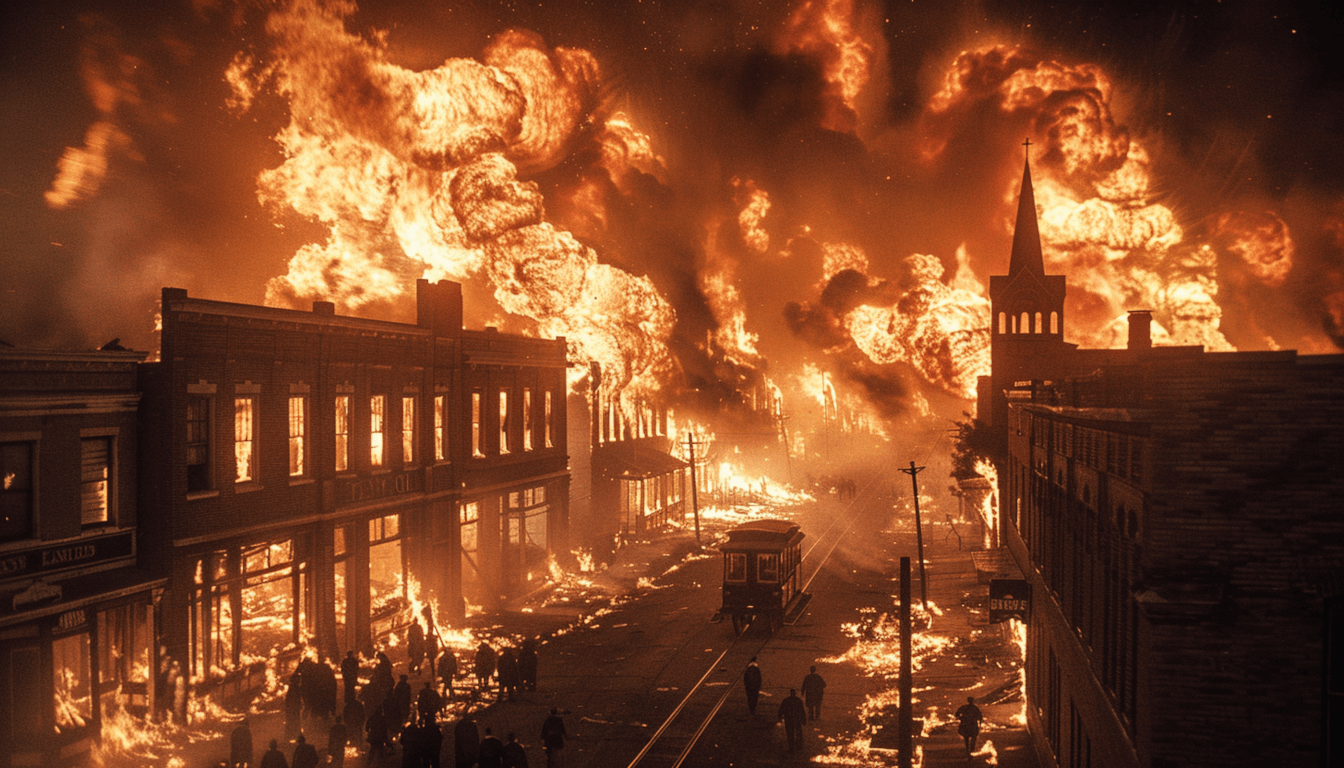🔥The Tulsa Race Massacre and the Echoes of Economic Violence
What happens when a thriving Black community becomes the target of state-enabled violence—and how does that loss reverberate across generations?
This article examines the 1921 Tulsa Race Massacre, an 18-hour assault on the Greenwood District, a neighborhood once hailed as Black Wall Street. Between May 31 and June 1, white mobs—some deputized by local authorities—burned more than 35 city blocks, destroyed over 1,000 Black-owned homes and businesses, and left nearly 10,000 residents homeless.
What unfolded in Tulsa was not an isolated riot—it was a coordinated act of racial terror that decimated one of the most prosperous Black communities in American history. The destruction of Greenwood marked a violent rupture in the trajectory of Black economic power, the effects of which are still felt today.
This guide synthesizes casualty estimates, property losses, internments, and the imposition of martial law. It draws from primary sources and authoritative research, including the National Endowment for the Humanities’ report, to provide a clear, data-driven account of what happened—and why it matters.
To understand the rise of Greenwood before the violence, see The Birth of Black Wall Street: A Hub of Black Excellence.
Key Takeaways
- The piece places the tulsa race riot and tulsa race massacre within U.S. history as among the worst urban racial attacks.
- It outlines what occurred across roughly eighteen hours and two days and why official actions mattered.
- Readers will see economic and human costs quantified for clarity.
- It explains how martial law and detention shaped survivor outcomes.
- The guide previews deeper sections on causes, media roles, relief, and memory.
🧨 What Sparked the Tulsa Race Massacre? Greenwood’s Destruction and the Scale of Loss
In late May and early June 1921, a concentrated eruption of anti-Black violence devastated Tulsa’s Greenwood District—then known as Black Wall Street. Over the course of two days, from May 31 to June 1, armed white mobs burned more than 35 blocks of a prosperous Black neighborhood, destroying homes, businesses, schools, and churches.
The violence began after an accusation involving Dick Rowland, a young Black shoeshiner, and Sarah Page, a white elevator attendant. A standoff at the courthouse on the evening of May 31 escalated into a full-scale invasion of Greenwood the following morning.
Official reports listed 36 deaths; a 2001 state commission confirmed 39. But survivor accounts and later research place the number far higher—some estimates approach 300. More than 800 people were injured, roughly 6,000 were detained, and nearly 10,000 Black residents were left homeless.
Historians use both “Tulsa Race Massacre” and “Tulsa Race Riot” to describe the event. The shift in terminology reflects evolving understanding of the attack’s intent, coordination, and consequences. City authorities, mass detentions, and martial law shaped both the violence and its aftermath.
For survivor accounts and federal findings, see DOJ Report on the Tulsa Race Massacre.
For a detailed timeline and analysis, visit the National Endowment for the Humanities.
🏛️ Setting the Stage: Segregation, Vigilantism, and Greenwood’s Rise
Greenwood’s success unfolded against a backdrop of codified segregation and rising racial hostility. After Oklahoma gained statehood, lawmakers enacted Jim Crow measures that restricted voting, jury service, and public office for African Americans. In 1916, Tulsa passed a residential segregation ordinance that further entrenched inequality.
At the same time, the Ku Klux Klan resurged. By late 1921, estimates suggest more than 3,200 members operated locally. Extralegal enforcement and vigilantism made daily life dangerous for Black residents—especially those who achieved economic success.
Despite these threats, Greenwood thrived. To explore its economic blueprint, see Economic Lessons from Black Wall Street.
🏙️ Greenwood’s Prosperity: Institutions, Entrepreneurs, and Community Power
Founded by visionary leaders like O.W. Gurley, the Greenwood District became a beacon of Black excellence. The neighborhood hosted newspapers, theaters, churches, medical and legal practices, and hundreds of businesses. Its economic density fostered pride, mutual support, and intergenerational opportunity.
Yet Greenwood’s visibility made it a target. In a city shaped by segregation and resentment, Black prosperity was seen as a threat—not a triumph.
For a deeper look at Greenwood’s rise, visit The Birth of Black Wall Street.
⚠️ Postwar Tensions and the Pressure Cooker of Racial Violence
The years following World War I brought new pressures. Returning veterans faced job competition, and the Red Summer of 1919 had already ignited racial violence across the country. Tulsa was not immune.
These tensions increased the likelihood that a local incident—like the elevator accusation—could trigger wider violence.
| Structural Factor | Effect on Residents | Greenwood Strengths |
| Segregation Laws (1916 ordinance) | Restricted rights and legal recourse | Self-reliant civic institutions |
| Klan Resurgence and Vigilantism | Heightened threat of extralegal violence | Close-knit community networks |
| Postwar Labor Competition | Economic friction between racial groups | Diverse businesses and entrepreneurs |
| Years of Discrimination | Limited political power for African Americans | Pride in local leadership and commerce |
Legal discrimination baked inequality into daily life. Vigilantism raised the cost of prosperity for minority entrepreneurs. Yet the Greenwood District stood as a testament to resilience, innovation, and community cohesion.
🚪 The Elevator Incident: Dick Rowland, Sarah Page, and the Spark That Ignited the Tulsa Race Massacre
On May 30, 1921, a brief encounter in the Drexel Building elevator set off a chain of events that would culminate in the destruction of Black Wall Street. Dick Rowland, a young Black shoeshiner, entered the elevator operated by Sarah Page, a white woman. Accounts of what happened vary: some describe a misstep and a startled reaction, while others allege assault. No written statement from Page survives, leaving the truth obscured by rumor and racial bias.
🗓️ Memorial Day Encounter and Conflicting Accounts
The incident could have quietly faded. Instead, it became a flashpoint. Rumors spread rapidly, fueled by conflicting witness accounts and the absence of clear evidence. In a city already primed by segregation and vigilantism, the ambiguity became a catalyst.
🚔 Arrest, Courthouse Transfer, and Fear of Mob Violence
Rowland was arrested and moved from the city jail to the county courthouse—allegedly for his protection. The transfer reflected growing fears of lynching, a threat made real by recent incidents across Oklahoma.
The Tulsa Tribune published the inflammatory headline:
“Nab Negro for Attacking Girl in an Elevator”
Some accounts claim the paper also ran an editorial inciting mob action, though no copy of that editorial has been preserved. The media’s role in escalating tensions remains a critical part of the massacre’s origin story.
To understand how Greenwood’s prosperity made it a target, visit The Legacy of Black Wall Street in Modern America.
📰 Media’s Role in the Tulsa Race Massacre: The Tulsa Tribune and a Disputed Editorial
Local reporting didn’t just relay facts—it helped shape the emotional tenor of a city on edge. On May 31, 1921, the Tulsa Tribune ran an afternoon edition with the inflammatory headline:
“Nab Negro for Attacking Girl in an Elevator”
This coverage followed the arrest of Dick Rowland and amplified racial tensions already simmering in Tulsa. The paper’s tone and timing played a critical role in escalating public outrage and mobilizing white mobs.
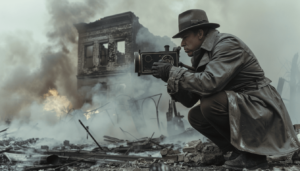
🕵️♂️ Disputed Editorials, Missing Editions, and Eyewitness Claims
Eyewitnesses later recalled a second editorial allegedly titled “To Lynch Negro Tonight.” That piece is absent from surviving microfilm archives, and no physical copy surfaced despite a public reward. Still, testimony and contemporaneous accounts suggest the editorial existed—and that it helped incite mob violence.
City officials later acknowledged that the Tribune’s tone inflamed crowds and influenced how police and municipal leaders responded. Other local papers did not reprint the alleged editorial, leaving a gap in physical evidence but not in historical consequence.
⚠️ Press Power and Responsibility
Even without definitive attribution, the sequence from headline to courthouse standoff is clear. In tense environments, sensational reporting can escalate racial violence within hours. This episode remains a cautionary tale in Oklahoma’s history about the power—and responsibility—of the press.
For a deeper dive into media complicity, visit Tulsa Race Massacre: Newspaper Coverage and Editorial Influence.
🌒 The Night of May 31: Courthouse Standoff, Deputization, and the First Gunfire of the Tulsa Race Massacre
As evening fell on May 31, 1921, tension outside the Tulsa County Courthouse escalated into a volatile confrontation. Hundreds of white men gathered in the square, demanding access to Dick Rowland, the Black teenager accused of assault. Twice, armed Black veterans—many of them World War I servicemen—offered to protect Rowland. Officials declined both offers.
🛑 Courthouse Crowd and the Sheriff’s Response
Sheriff McCullough attempted to balance legal duty with public pressure. His decision to keep Rowland at the courthouse, without additional protection, left the crowd agitated and the situation unstable. Anxiety mounted as rumors of a lynching spread through both Black and white communities.
🧨 Armory Breach Attempt and Street Skirmishes
An attempted breach of the National Guard armory failed, but the crowd did not disperse. City leaders authorized ad hoc deputization, arming white civilians and escalating the threat. What began as a courthouse standoff spilled into the streets, with skirmishes erupting near the Frisco railroad tracks.
🔫 “All Hell Broke Loose”: The First Fatalities
Eyewitnesses describe a flashpoint moment when an elderly white man tried to disarm a Black veteran. A single gunshot triggered chaos.
“All hell broke loose.”
By midnight, at least a dozen people lay dead. Panic spread through Tulsa as false reports and rumors shaped decisions on both sides. The city was now on the brink of full-scale racial violence.
To understand how Greenwood’s prosperity made it a target, visit Economic Lessons from Black Wall Street.
Why this night mattered: the hour-by-hour move from standoff to exchange of gunfire turned a charged incident into a sustained race riot and set the tactical conditions for the dawn assault on Greenwood. For further context on the event’s legacy, see Greenwood Rising and its legacy.
🌅 June 1, 1921: Greenwood’s Invasion and the Systematic Destruction of Black Wall Street
In the early hours of June 1, 1921, the Tulsa Race Massacre escalated into a coordinated assault on the Greenwood District. Armed white mobs moved through streets and alleys, setting homes and businesses ablaze and forcing Black residents into the open. What unfolded was not random—it was a planned invasion marked by arson, looting, and targeted violence.

🔥 Greenwood District Under Siege: Arson, Looting, and Targeted Home Invasions
Attackers conducted house-to-house raids with alarming coordination. Buildings were torched while men rifled through property and rounded up residents. Fires were deliberately set in dense commercial and residential blocks to maximize destruction and displace thousands.
This pattern of violence reflected intent—not chaos. Greenwood’s prosperity made it a target, and its destruction was executed with precision. For a detailed overview of the district’s layout and vulnerability, see Black Wall Street: Tulsa’s Greenwood District and the Legacy of Economic Power.
💣 Heavy Weapons and Standpipe Hill Resistance During the Tulsa Race Massacre
Eyewitnesses reported the use of machine guns, and some claimed that airplanes strafed the district. While contemporary records confirm the deployment of heavy weapons, reports of aerial attacks remain contested. For historical context and survivor accounts, explore Personal Stories from the Survivors of Black Wall Street.
Black defenders—including war veterans—staged fierce resistance near Standpipe Hill, but they were ultimately overwhelmed by superior firepower and numbers.
🩺 Dr. A. C. Jackson’s Death: Targeted Killing During the Tulsa Race Massacre
Even surrender did not guarantee safety. Dr. A. C. Jackson, a respected Black surgeon, was murdered after giving himself up—an act that underscores the deliberate brutality of the assault. His death remains one of the most documented and devastating examples of targeted violence during the massacre. For official documentation and historical analysis, visit the Oklahoma Historical Society’s encyclopedia entry on the Tulsa Race Massacre.
🕛 Martial Law Declared: Greenwood District in Ashes by Noon, June 1
By 9:15 a.m., additional National Guard units arrived. By noon, martial law was declared. Much of Greenwood lay in ruins—its homes, businesses, and institutions reduced to ash. The morning’s organized assault shaped both the scale of the massacre and the long aftermath for Tulsa’s Black community.
📉 Human Toll and Material Losses from the Tulsa Race Massacre
Within hours on June 1, 1921, a concentrated campaign of racial violence turned Tulsa’s Greenwood District—known as Black Wall Street—into ruins. The destruction displaced thousands and erased decades of Black economic progress.
This section consolidates verified casualty counts, detention figures, and property losses to illustrate both the immediate harm and the long-term devastation. For deeper insight into Greenwood’s economic legacy and the scale of loss, revisit Black Wall Street: Tulsa’s Greenwood District and the Legacy of Economic Power.
⚰️ Deaths, Injuries, and Mass Detentions
- Official death toll: 36
- 2001 commission confirmation: 39
- Survivor and historian estimates: Up to 300
More than 800 people were injured, including 232 listed as seriously wounded. Authorities detained up to 6,000 Black residents, holding them in makeshift camps, jails, and fairgrounds for days after the violence.
🏚️ Destruction of Homes, Businesses, Churches, and Schools
Attackers burned over 35 city blocks, destroying more than 1,000 homes and businesses. Churches, schools, and civic institutions were also targeted—erasing the infrastructure that anchored daily life in Greenwood.
Vital documents like deeds, ledgers, and business records were lost in the fires, making recovery and compensation nearly impossible for survivors.
📊 Scale of Devastation: Hours of Violence, Generations of Impact
Though the assault lasted only a few hours, its effects were generational. Approximately 10,000 Black residents were left homeless. Property losses were staggering:
| Metric | Official Count | Confirmed / Range | Notes |
| Deaths | 36 | 39; estimates up to 300 | Record gaps and missing burials produce range |
| Injuries | 800+ | 232 serious | Medical reports and survivor testimony |
| Detentions | — | Up to 6,000 detained | Held in jails and temporary camps for days |
| Property Destroyed | 35+ blocks; 1,000+ homes & businesses | $1.5M real estate; $750K personal property | 1921 Tulsa monetary values; records lost in fires |
In 1921 dollars, the estimated property loss totaled $1.5 million in real estate and $750,000 in personal property. Adjusted for inflation, the economic impact reaches into the hundreds of millions—an enduring blow to Black generational wealth.
🚨 Martial Law, Relief Efforts, and the Red Cross Response to the Tulsa Race Massacre
By noon on June 1, 1921, armed units moved into Tulsa’s Greenwood District to enforce order and manage the aftermath of the Tulsa Race Massacre. The declaration of martial law shifted authority from local officials to state forces, setting the terms for rescue, detention, and emergency response.
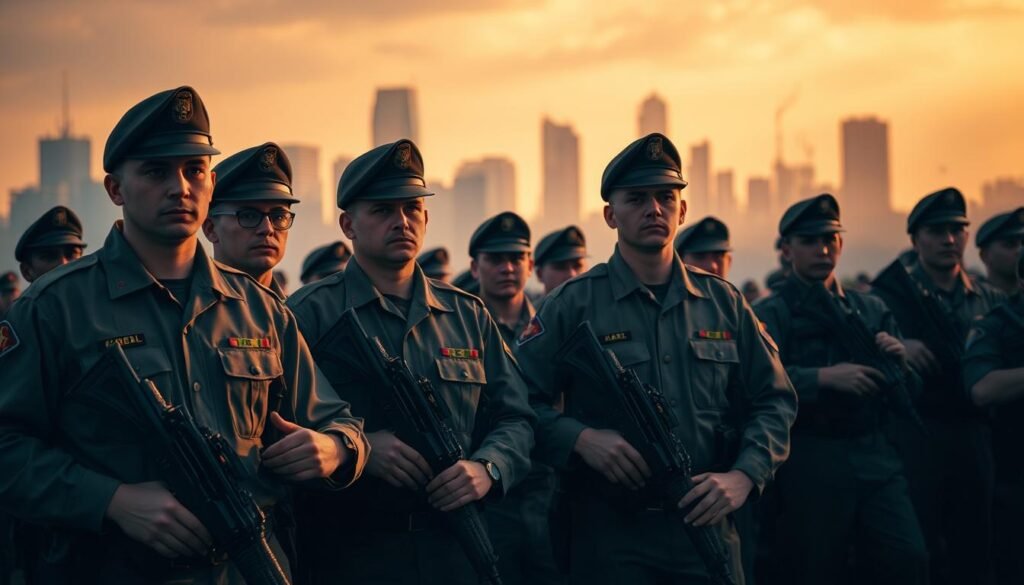
🪖 National Guard Mobilization and Mass Detention of Black Residents
The National Guard secured perimeters and escorted thousands of displaced Black residents to processing sites. Families faced disarmament, identification checks, and long waits before release. Detention camps—set up in fairgrounds and other public spaces—held residents for days.
Later reports documented guard procedures, timelines, and the conditions inside these camps. The mass internment added another layer of trauma to an already devastated community.
🏥 Red Cross Aid, City Resistance, and Emergency Shelter
The American Red Cross established medical stations, food distribution centers, and tent communities—despite resistance from some city officials. Churches and neighborhood groups stepped in to fill gaps, organizing kitchens and temporary shelters for survivors.
While short-term relief addressed urgent needs, it did not resolve long-term displacement. Many survivors lacked deeds, records, or legal documentation to reclaim property, prolonging hardship and delaying recovery.
📋 Coordinated Response and Outcomes
| Response | Primary Actor | Outcome |
| Perimeter Security | National Guard | Controlled access; mass detentions |
| Emergency Relief | Red Cross & Churches | Tents, food, medical care |
| Documentation | City / State Officials | Early reports guided later claims and inquiries |
⚖️ Legal Fallout from the Tulsa Race Massacre: Barriers to Justice and Recovery
The legal aftermath of the 1921 Tulsa Race Massacre turned recovery into a prolonged battle over evidence, insurance claims, and municipal obstruction. Survivors faced systemic barriers at every level—from criminal investigations to civil restitution.
🧑⚖️ Grand Jury Findings and the Absence of Prosecutions
An all-white grand jury issued a report that shifted blame onto Black residents while clearing most white perpetrators. Though Dick Rowland was later exonerated, no white individual was prosecuted for murder, arson, or looting. The Oklahoma Historical Society’s account of the massacre’s aftermath outlines how law enforcement and judicial systems failed to deliver justice.
The role of Tulsa police leadership remained under scrutiny for authorizing deputizations and failing to intervene. Ultimately, criminal accountability collapsed at both the city and state levels.
🧾 Insurance Denials, Fire Ordinances, and Civil Litigation
Insurance companies denied most claims, citing civil unrest exclusions rather than accidental fire. According to Justice for Greenwood, over 1,400 lawsuits were filed for more than $4 million in property losses, but nearly 95% were denied due to “riot” clauses in policies.
In the aftermath, Tulsa enacted new fire ordinances and zoning laws that further obstructed rebuilding efforts. Attorney B. C. Franklin, whose own office was destroyed, famously set up a tent to continue practicing law and filed suits challenging these ordinances. His 1931 manuscript, “The Tulsa Race Riot and Three of Its Victims”, offers a firsthand legal and personal account of the massacre’s impact and the fight for civil compensation.
While some plaintiffs secured limited recovery, many cases were undermined by lost deeds, receipts, and business records—documents destroyed in the fires.
📊 Legal Barriers and Their Impact on Greenwood’s Recovery
| Legal Area | Primary Actor | Outcome | Impact |
| Grand Jury Report | County Grand Jury | Blamed Black residents; no white prosecutions | Criminal impunity |
| Police Action | City / Tulsa Police | Deputizations; contested inaction | Accountability questions |
| Insurance Claims | Private Insurers | Denials or partial payments | Financial loss, slowed recovery |
| Civil Litigation | Attorneys (e.g., B. C. Franklin) | Some legal wins; limited restitution | Protracted, often inadequate relief |
Evidence gaps and hostile administrative rulings blocked full restitution. Civil law efforts could not replace the absence of criminal justice. The legal environment prolonged economic harm for every man, woman, and family seeking redress.
For a federal review that addresses institutional findings, see the Justice Department’s official report.
🏗️ Rebuilding Black Wall Street: Resilience and Recovery in the Greenwood District
In the wake of the 1921 Tulsa Race Massacre, residents of the Greenwood District—known as Black Wall Street—mobilized to rebuild their homes, businesses, and institutions. Through mutual aid, legal advocacy, and community organizing, survivors transformed devastation into a determined comeback.
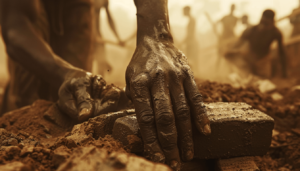
🧱 Community Leadership, Legal Advocacy, and Return Migration
Leadership councils coordinated shelter, food, and funding. Attorneys like B. C. Franklin challenged Fire Ordinance No. 2156, which threatened to strip survivors of their land titles. Legal teams preserved deeds and fought restrictive permits, enabling families to reclaim property and return to Greenwood.
🏠 Reconstruction of Homes and Businesses
By the end of 1922, many homes had been rebuilt. Relief flowed from Red Cross efforts, philanthropic donations, and grassroots aid—despite resistance from some city officials. Over the following years, small shops, offices, and service providers reopened, restoring the district’s commercial heartbeat.
📈 From 1922 to Mid-Century: Economic Recovery and Urban Renewal Pressures
Greenwood’s commercial momentum returned. The National Negro Business League held its convention in Tulsa in 1925, and by 1942, more than 200 Black-owned businesses operated in the district.
Yet the mid-century brought new challenges. Urban renewal projects and highway construction fragmented Greenwood’s economic core, undermining long-term gains and displacing residents once again.
📊 Rebuilding Black Wall Street: Key Recovery Actions and Outcomes
| Area | Action | Outcome |
| Legal Advocacy | Challenged ordinances and defended land deeds | Enabled rebuilding and protected property rights |
| Relief & Funding | Red Cross, philanthropies, and local aid | Emergency shelter; seed capital for businesses |
| Commercial Recovery | Reconstruction of stores and offices | 200+ businesses by 1942; renewed services and jobs |
Community organizing and legal resistance anchored Greenwood’s recovery. The rebuilt neighborhood stood as a testament to Black resilience—but it would continue to face structural threats in the decades ahead.
🕯️ Silence, Suppression, and the Public Memory of the Tulsa Race Massacre
For decades after the 1921 Tulsa Race Massacre, public accounts minimized or omitted the destruction of the Greenwood District. Institutional silence and social stigma pushed the event to the margins of textbooks, civic records, and local commemorations. This absence shaped how generations learned—or didn’t learn—about the victims, the violence, and the scale of loss.
📚 Erasure from Local and National Histories
For much of the 20th century, school curricula excluded the massacre entirely. Media gaps and municipal reluctance erased key facts about property destruction, mass detentions, and racial violence.
This omission delayed public recognition and complicated restitution efforts. Only in the early 2000s did Oklahoma mandate formal teaching of the massacre, with expanded curriculum coverage arriving in 2020.
🗣️ Survivor Testimonies, Oral Histories, and Lost Records
Survivor accounts—such as Mary E. Jones Parrish’s Events of the Tulsa Disaster—preserved evidence when official files vanished. Oral histories, church ledgers, and community archives kept names and needs alive.
Historical societies and independent researchers later worked to match burial records, reconstruct timelines, and locate missing documentation. Red Cross logs and church archives often filled gaps left by municipal files.
📊 Sources Preserving the Tulsa Race Massacre: Contributions and Limitations
| Source | Contribution | Limitations |
| Survivor Testimonies | Personal accounts, names, eyewitness evidence | Memory gaps; varied detail across years |
| Historical Society Projects | Archival searches, compiled reports, public outreach | Incomplete holdings; reliance on donated materials |
| Red Cross & Church Records | Relief logs, burial notes, shelter lists | Fragmented records; access restrictions at times |
Community leadership sustained remembrance through memorials, education initiatives, and public pressure. Recovering evidence required sustained archival work and advocacy.
Memory is active work—preserving victims’ names resists erasure and reshapes public history.
🧪 Modern Scholarship and the 2001 Commission: Investigating the Tulsa Race Massacre

In the late 1990s, renewed public pressure led to a formal investigation into the 1921 Tulsa Race Massacre. The 1996–1997 state commission launched a multidisciplinary effort to assemble records, survivor testimony, and technical studies. This work culminated in the 2001 Tulsa Race Riot Commission Report, which clarified disputed facts and set a public agenda for research, education, and redress.
📜 Tulsa Race Massacre Commission Report and Burial Site Investigations
The commission confirmed 39 deaths and acknowledged estimates as high as 300. Researchers combined archival searches with oral interviews to refine casualty counts and document survivor experiences.
Teams from state universities and historical societies used ground-penetrating radar (GPR) and forensic analysis to locate possible mass graves. This work produced new physical evidence and guided respectful scientific study of burial sites.
💰 Reparations, Archival Evidence, and Public Records from the Tulsa Race Massacre
The 2001 report recommended reparations for survivors and descendants. While the legislature approved scholarships and memorial projects, full reparations stalled amid political and legal debate.
Researchers reconstructed municipal files, medical logs, and insurance records to support claims and expand public understanding. Increased access to these records improved media coverage, classroom teaching, and community advocacy around the massacre.
📊 Tulsa Race Massacre: Commission Findings, Forensic Methods, and Policy Outcomes
| Area | Method | Outcome |
| Casualty Review | Archival + Oral History | 39 Confirmed; Range Up to 300 |
| Burial Site Study | GPR + Forensics | Possible Graves Identified |
| Policy Response | Commission Recommendations | Scholarships, Memorials, Ongoing Debate |
“Ongoing evidence review remains central to truth‑telling and community healing.”
Commission findings renewed advocacy and scholarship. Multidisciplinary teams linked archives to forensics, and public records expanded the historical record.
🎓 Legacy of the Tulsa Race Massacre in Education, Culture, and Civic Life
In the decades since the 1921 Tulsa Race Massacre, public memory has shifted from silence to sustained engagement. Through state mandates, university partnerships, and civic initiatives, the story of the Greenwood District has moved into classrooms, museums, and community forums—reshaping how history is taught and remembered.
📘 Tulsa Race Massacre Curriculum Mandates and Centennial Education Projects
Since 2002, Oklahoma has required instruction on the Tulsa Race Massacre in public schools. In 2020, the topic was formally integrated into the state’s official curriculum. Collaborations between state universities and the Oklahoma Historical Society produced detailed teaching guides and classroom resources.
Centennial initiatives—such as the Greenwood Art Project, museum exhibitions, and public installations—created lasting educational and cultural infrastructure. These programs ensure that the massacre is not only remembered but taught with depth and context.
🏛️ Greenwood District Legacy in Black Entrepreneurship and Civic Dialogue
Greenwood’s legacy as a hub of Black entrepreneurship and community resilience continues to inspire civic dialogue. Its story informs conversations about racial equity, economic justice, and historical truth.
Popular culture, documentaries, and public forums have brought new audiences to museums, memorials, and educational events, transforming Greenwood into a national symbol of both tragedy and tenacity.
“Sustained attention to history turns memory into civic learning.”
📊 Education, Museums, and Community Engagement After the Tulsa Race Massacre
| Area | Actor | Impact |
| Curriculum | State Department & State Universities | Required lessons; teacher resources |
| Cultural Projects | Museums & Historical Society | Exhibitions, public art, centennial programs |
| Community Engagement | Local Organizations | Forums, school outreach, tourism, and public education |
🗺️ Location and Timeline of the Tulsa Race Massacre: Mapping Greenwood and the Hours of Destruction
The Greenwood District—centered at 36.15972 N, -95.98583 W—was a compact commercial grid in Tulsa, Oklahoma. This precise location helps map how a concentrated pocket of Black-owned homes, businesses, and institutions became the epicenter of the 1921 Tulsa Race Massacre.
🕰️ Timeline of the Tulsa Race Massacre: May 31–June 1, 1921
- Evening of May 31: Courthouse standoff begins as crowds gather and tensions escalate.
- Pre-dawn, June 1: Armed white mobs organize and move toward Greenwood.
- Dawn: Coordinated invasion begins, with rapid arson, looting, and forced displacement.
- 9:15 a.m.: National Guard reinforcements arrive.
- By noon: Martial law is declared.
Within an 18-hour window, attackers destroyed more than 35 blocks and over 1,000 homes and businesses, displacing thousands and erasing decades of Black prosperity.
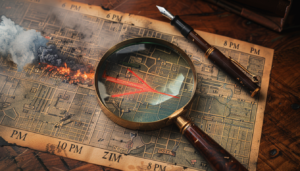
🧭 Greenwood’s Layout and the Strategic Spread of Violence
The district’s compact layout concentrated both economic life and vulnerability. Failed armory breaches, fighting near Standpipe Hill, and troop movements shaped which blocks were burned and which were spared.
“The sequence of hours shaped both immediate rescue efforts and later records used to estimate the number of victims.”
Understanding the timeline is critical—it links phases of arson, mass detentions, and military deployment to the scale of destruction and the city’s response.
🗣️ Language and Naming: Why “Tulsa Race Massacre” Terminology Matters in Law, Education, and Public Memory
What historians, educators, and policymakers call the 1921 Tulsa destruction carries weight. A single term—“riot” versus “massacre”—can shape legal claims, insurance outcomes, and how generations understand the violence against the Greenwood District.
⚖️ How “Riot” vs. “Massacre” Shaped Law, Insurance, and Public Understanding
Early reports labeled the event the “Tulsa Race Riot,” a term that implied mutual disorder rather than a one-sided racial assault. This framing influenced courtroom interpretations and allowed insurance companies to classify property losses as civil unrest, which often voided coverage.
The later adoption of “Tulsa Race Massacre” in commission findings, academic scholarship, and state curriculum reframed the event as organized, racialized violence. This shift strengthened arguments for accountability and reparative justice.
🏛️ Impact of Tulsa Race Massacre Terminology on Education, Museums, and Memorials
Language matters in museums, school curricula, and public memorials. When official reports and teaching materials use precise terms like “massacre,” they center victims and clarify agency. When older records retain “riot,” researchers must note the historical context and legal consequences.
- “Riot” language shaped insurance denials and legal defenses
- “Massacre” aligns with evidence of coordinated attacks and supports reparative narratives
- Updated naming affects how Black Wall Street history is taught, commemorated, and understood
“Accurate naming supports accountability and truthful commemoration.”
To explore how Greenwood’s legacy is preserved through education and public history, visit The Legacy of Black Wall Street in Modern America.
🔥 Tulsa Race Massacre: Causes, Consequences, and Enduring Impact on the Greenwood District
A sequence of rapid decisions—arming civilians, inflammatory headlines, and a tense courthouse standoff—turned a local crisis into wide-scale destruction. This synthesis links immediate triggers to deeper structural causes and long-term outcomes for Tulsa’s Greenwood District, also known as Black Wall Street.
📰 Newspaper Coverage, Deputization, and State Response During the Tulsa Race Massacre
Sensational newspaper framing intensified fear and mobilized white crowds. Deputization gave civilians weapons and turned crowd control into organized violence.
“All hell broke loose.”
By noon on June 1, the National Guard imposed martial law, and mass detentions followed. The 2001 Tulsa Race Riot Commission later estimated up to 300 deaths. Dick Rowland was exonerated, yet no white perpetrator faced prison for the massacre.
⚖️ Legal Redress, Community Recovery, and the Long Arc of Accountability
The massacre’s consequences included deaths, mass detentions, and the crippling of Greenwood’s economic base. While rebuilding advanced by 1922, later urban renewal projects eroded mid-century gains.
Legal efforts ranged from denied insurance claims to civil suits and commission recommendations. Teams from state universities and the Oklahoma Historical Society helped document losses and press for restitution.
📊 Summary of Tulsa Race Massacre: Cause, Consequence, and Legacy
- Cause: Media framing, municipal decisions, and crowd dynamics
- Consequence: Property destroyed, community displaced, contested number of victims
- Legacy: Legal limits, resilience, and ongoing debate over reparations and historical accountability
🧠 Final Reflections on the Tulsa Race Massacre and the Legacy of Black Wall Street
The 1921 Tulsa Race Massacre remains one of the most devastating acts of racial violence in U.S. history. More than 35 blocks of the Greenwood District—a thriving Black business community—were burned. Thousands were displaced, and casualty estimates reach up to 300 lives lost.
By 1922, survivors and community leaders had rebuilt much of Greenwood. Later state commissions, curriculum reforms, and public memorials expanded historical awareness and pressed for evidence-based accounting of the victims.
🏛️ Law, Media, and the Long Struggle for Historical Repair
Legal systems, media narratives, and civic institutions shaped both the harm and the long arc of redress. From insurance denials to civil suits, and from oral histories to state reports, the fight for recognition and restitution continues.
To explore the official historical record, read the Oklahoma Historical Society’s encyclopedia entry on the Tulsa Race Massacre, which outlines key events, legal responses, and long-term impact.
For firsthand accounts, visit Personal Stories from the Survivors of Black Wall Street, a curated archive of testimony and lived experience.
To understand Greenwood’s economic legacy, explore Black Wall Street: Tulsa’s Greenwood District and the Legacy of Economic Power, which traces entrepreneurship, resilience, and systemic barriers.
“Remembering Black Wall Street demands sustained education, dignity for descendants, and accountable public policy—so those lessons guide future years.”
FAQ
What was the 1921 massacre and what triggered the violence?
The 1921 massacre began after a tense encounter in an elevator between a young Black man, Dick Rowland, and Sarah Page, a white elevator operator. Sensational newspaper headlines, a crowd outside the courthouse, and fears of a lynching escalated the situation. Tensions already simmered from postwar labor pressures, segregation laws, and violent vigilantism, which turned the incident into widespread armed attacks on Greenwood, the prosperous Black neighborhood known as “Black Wall Street.”
How did segregation and white supremacist groups contribute to the destruction?
State and local Jim Crow ordinances enforced segregation and limited political power for African Americans. The Ku Klux Klan’s resurgence and local vigilantism created a climate where threats of violence went unchecked. Those forces, combined with economic resentment of Greenwood’s success, made large-scale organized attacks and arson more likely and harder to stop.
What role did the local press play in the events?
The local paper, the Tulsa Tribune, published inflammatory coverage and a disputed editorial that helped inflame public opinion. Eyewitnesses later reported discrepancies in editions and sensational headlines that encouraged armed white crowds to assemble, contributing directly to the outbreak of violence.
What occurred during the night of May 31 and the morning of June 1?
On the night of May 31, a courthouse standoff, deputizations of armed civilians, and exchanges of gunfire escalated. By dawn on June 1, organized armed groups entered Greenwood, setting fires, looting businesses and homes, and committing widespread violence. Residents tried to defend the community from locations such as Standpipe Hill while others were driven into detention and makeshift camps.
Were aircraft used during the attacks?
Multiple eyewitnesses and some historical reports describe planes circling overhead and strafing or dropping incendiaries, though the full extent and documentation remain debated among historians. Machine-gun fire and other heavy weapon use are well attested in survivor accounts and contemporary records.
What were the human and material costs?
Hundreds of homes and businesses, several churches, and schools were destroyed. Hundreds of people were killed or injured; thousands were left homeless and incarcerated in detention centers or camps. The community’s economic base, known as Black Wall Street, suffered catastrophic losses that affected generations.
How did authorities respond in the immediate aftermath?
The National Guard was mobilized and martial law imposed. Many Black residents were detained in internment camps. Relief agencies, including the Red Cross, provided aid but faced resistance from city officials who tried to limit assistance and control property recovery, complicating relief and rebuilding efforts.
Were there legal consequences or prosecutions for the violence?
Official grand juries and investigations at the time did not produce prosecutions of white perpetrators. Insurance companies commonly denied fire claims citing ordinances or riot exclusions. Decades later, state and city actions to investigate accountability and reparations met legal and political obstacles.
How did the community rebuild after such destruction?
Survivors and community leaders organized reconstruction, reestablishing many businesses and institutions despite hostile local policies and limited capital. Recovery began in the early 1920s but faced setbacks from discriminatory practices and later urban renewal projects that further disrupted neighborhoods.
Why was this event omitted from many histories for so long?
Local suppression, lost or destroyed records, and deliberate silence in schools and public discourse contributed to erasure. Survivor trauma and community pressure also limited early documentation. Oral histories, archival research, and later commissions have been essential to restoring memory.
What have modern investigations and commissions concluded?
State and local commissions since the 1990s compiled evidence, recommended reparations, and documented burial sites and mass graves. Reports highlighted failures of law enforcement and government officials to protect citizens and called for measures to address historical injustices.
What efforts exist today to educate the public and honor victims?
Museums, historical societies, centennial projects, curriculum changes in Oklahoma schools, and memorials have increased public awareness. Scholarship, documentaries, and survivor testimonies continue to inform civic debate about redress, commemoration, and the legacy of economic violence against Black communities.
How does terminology affect understanding and policy?
Calling the event a “massacre” rather than a “riot” shifts emphasis from spontaneous unrest to organized assault and civilian targeting, affecting legal, insurance, and reparations discussions. Terminology influences public memory, official records, and the urgency of restorative actions.
Where can one find primary sources and reliable scholarship?
Primary sources include contemporaneous newspaper archives, oral histories collected by state archives and universities, National Guard records, Red Cross reports, and the 1997 and 2001 commission records. Trusted scholarship comes from historians at institutions such as the University of Oklahoma and the Oklahoma Historical Society.
Related Articles
- The Legacy of Black Wall Street in Modern America
- The 1921 Tulsa Race Massacre: A Tragic Turning Point
- The Birth of Black Wall Street: A Hub of Black Excellence
